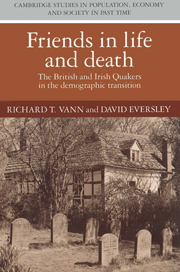Book contents
- Frontmatter
- Contents
- List of figures
- List of tables
- Preface
- Introduction
- 1 The quality of the sources
- 2 Characteristics of the sample
- 3 Marriage according to Truth
- 4 The fruitfulness of the faithful
- 5 The quality and quantity of life
- Conclusion
- Bibliography
- Index
- Cambridge Studies in Population, Economy and Society in Past Time
Conclusion
Published online by Cambridge University Press: 23 September 2009
- Frontmatter
- Contents
- List of figures
- List of tables
- Preface
- Introduction
- 1 The quality of the sources
- 2 Characteristics of the sample
- 3 Marriage according to Truth
- 4 The fruitfulness of the faithful
- 5 The quality and quantity of life
- Conclusion
- Bibliography
- Index
- Cambridge Studies in Population, Economy and Society in Past Time
Summary
In some ways the sources available to the student of British and Irish Quaker demography are the best that historical demographers have used. We are able to track the mobile part of the population; births, not baptisms, are recorded; there was a centralized system to oversee the activities of individual registrars; and we have a good deal of literary evidence from the Quakers themselves. These rich sources make it possible to offer with some confidence a summary view of the demography of the British and Irish Quakers; but we shall also give something like a concluding unscientific postscript – unscientific in the sense that of necessity the ratio of speculative inferences to straight conclusions from hard statistical evidence may be somewhat higher than in the preceding chapters.
For analytical purposes, nuptiality, fertility, and mortality were treated in separate chapters. Where necessary we sketched the relationships among the three, but without assessing their joint impact on population change. We do not have the sort of aggregative figures that could allow the computation of a net reproductive rate, and we know that emigration, disownment, and conversions had a very great effect on the total numbers of Quakers. We can, however, offer a crude technique for estimating what the effect of purely demographic changes would have been if the population had been closed and if the families for which we know the number of children ever born are representative of the whole.
- Type
- Chapter
- Information
- Friends in Life and DeathBritish and Irish Quakers in the Demographic Transition, pp. 239 - 255Publisher: Cambridge University PressPrint publication year: 1992

